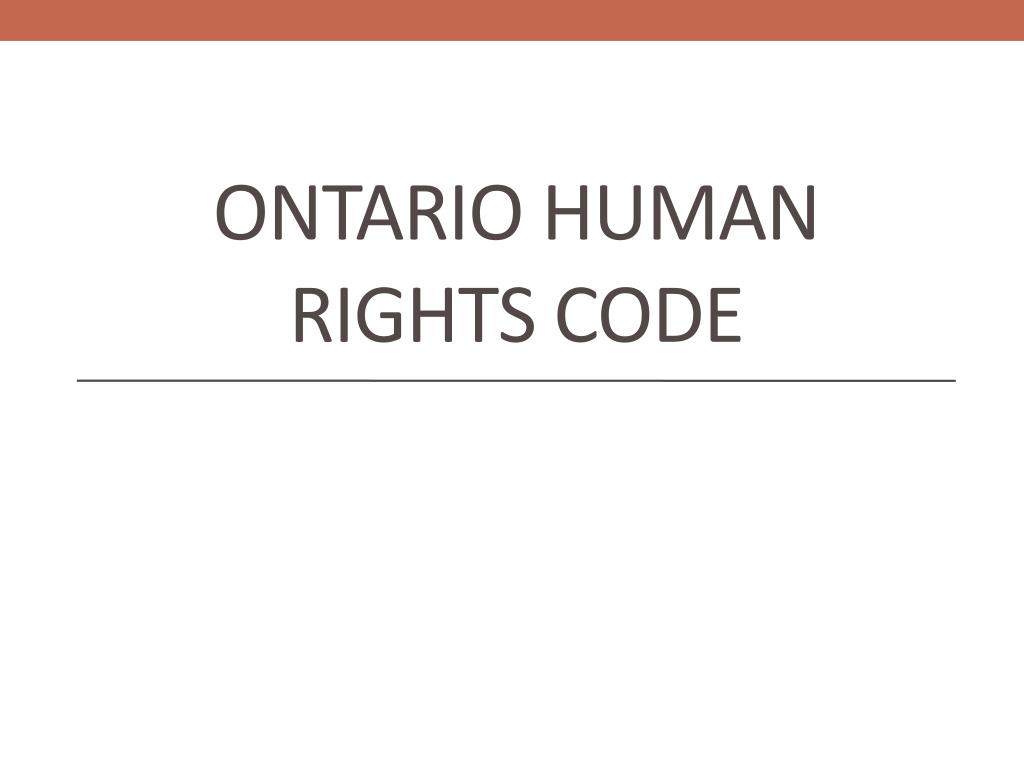
The Ontario Human Rights Code (Code) is a provincial law that gives everybody equal rights and opportunities without discrimination in the social areas of:
- employment
- accommodation
- goods
- services and facilities
- membership in vocational associations and trade unions
The Code's goal is to prevent discrimination and harassment because of:
- race
- ancestry
- place of origin
- colour
- ethnic origin
- citizenship
- creed (religion)
- sex (including pregnancy and gender identity)
- sexual orientation
- disability
- age (18 and over, 16 and over in occupancy of accommodation)
- marital status (including same sex partners)
- family status
- receipt of public assistance (in accommodation only)
- record of offences (in employment only).
The Ontario Human Rights Code is for everyone. It is a provincial law that gives everybody equal rights and opportunities without discrimination in areas such as jobs, housing and services. The Code’s goal is to prevent discrimination and harassment because of race, sex, disability and age, to name a few of the 17 grounds. All other Ontario laws must agree with the Code.
The Code was one of the first laws of its kind in Canada. Before 1962, various laws dealt with different kinds of discrimination. The Code brought them together into one law and added some new protections.
In June 2008, major changes designed to renew Ontario’s human rights system came into effect. Ontario’s human rights system now consists of three separate and independent parts:
- the Human Rights Tribunal of Ontario
- the Human Rights Legal Support Centre
- the Ontario Human Rights Commission.
The Human Rights Tribunal of Ontario (the Tribunal) decides if someone’s human rights have been violated. If you think your rights under the Code have been violated, you can file a complaint – called an application – directly with the Tribunal. The Tribunal will decide the best way to deal with your situation. It may also decide that your rights have not been violated or that it does not have the power to deal with your case.
The Human Rights Legal Support Centre (the Legal Support Centre) helps people who file applications with the Tribunal. Services may include advice, support and legal representation.
The Ontario Human Rights Commission (the OHRC) works to identify the root causes of discrimination, and to bring about broad, systemic change to remove them. It develops policies and provides public education, monitors human rights, does research and analysis, and conducts human rights public interest inquiries. While it does not deal with individual human rights complaints, the OHRC may take its own cases, or intervene in human rights cases before tribunals or courts on issues of broad public interest.
The Code is divided into an introductory section, or “preamble” followed by seven main parts. Part I sets out basic rights and responsibilities. Part II explains how the Code is interpreted and applied. Part III explains the role and structure of the Commission. Part IV explains how the Tribunal works and how the Code is enforced. Part IV.1 explains the role of the Legal Support Centre. Part V deals with general matters, such as the power to make regulations. Finally, Part VI deals with transitional matters.
Preamble
Whereas recognition of the inherent dignity and the equal and inalienable rights of all members of the human family is the foundation of freedom, justice and peace in the world and is in accord with the Universal Declaration of Human Rights as proclaimed by the United Nations;
And Whereas it is public policy in Ontario to recognize the dignity and worth of every person and to provide for equal rights and opportunities without discrimination that is contrary to law, and having as its aim the creation of a climate of understanding and mutual respect for the dignity and worth of each person so that each person feels a part of the community and able to contribute fully to the development and well-being of the community and the Province;
And Whereas these principles have been confirmed in Ontario by a number of enactments of the Legislature and it is desirable to revise and extend the protection of human rights in Ontario;
The Preamble to the Code was inspired by the 1948 Universal Declaration of Human Rights, an international statement of rights agreed to by many of the world’s nations. It is the basis for many of our human rights protections in Canada and around the world. The Preamble sets the tone and spirit for the Code’s basic aim: to create a climate of understanding and respect for all persons, without discrimination.
The courts have said that because of the importance of the principles set out in the Code, it should be given a broad and generous interpretation. When there is a difference or conflict between the Code and another Ontario law, the Code has priority unless the other law specifically states otherwise.

